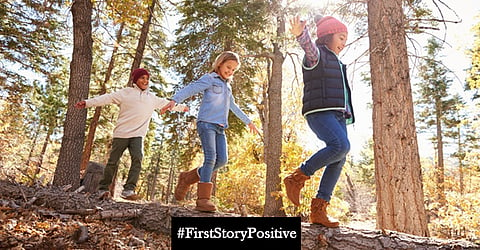

It is not uncommon to hear every other child lamenting about how boring school is or how nothing is learnt in the classroom. Some even say that the confines of the classroom are damaging for their mental health. Also, worth mentioning is the unbridled energy of the enthusiastic eager-to-learn students which is quashed when they are made to sit 6 hours a day, not being allowed to move. It can be argued, with citations, that such a situation is not productive and hence hinders the student’s ability to reliably absorb information. So, what’s the alternative? Enter Nature Schools, which are cropping up all around the world, most notably in New Zealand where more than 80 such schools have been established across the country with a community of over 20,000 skilled educators and teachers.
The idea of a nature school is to let children explore and learn from mother nature herself. Embodying the idea of a “classroom without walls”, the formal structure of a classroom is put aside in favor of play and self-directed learning. The schools are inspired by the Scandinavian culture of friluftsliv which literally translates to “free-air life”, wherein outdoor life is prioritized over living indoors. Locally, the school program directors take a distinctly New-Zealand approach in teaching, including Māori knowledge systems in the curriculum to guide planting, conservation and nature preservation. Māori are the indigenous people of mainland New Zealand (Aotearoa in their indigenous language).
Compared to traditional classroom, this approach allows for more productive learning for children. Rather than textbooks, children are taught to learn from all their senses. Children engage in team activities like building a structure, gardening together, risky activities like safe trekking, foraging, shelter building etc, supervised by trained educators where they use different tools, learn from each other, make way for creativity and develop superior social skills. Studies also suggest that spending time outdoors provides numerous psychological and physiological benefits to the young children such as improved immunity and faster cognitive development. Most notably it inspires a environmentally conscious behaviour, fuelled by empathy and appreciation for the natural world.
In India, Nature schools, more prominently known as forest schools, are inspired by the principle of Gurukul. The concept of Gurukul has been predominant in India since the ancient times, wherein students live on the school premises doing all the chores and maintaining upkeep of the place. They had to serve their guru and the place in order to learn everything they needed to know. They even went out into the forests to forage and scavenge for resources. They learnt nature maintenance in maintaining the greenery of their school and building structures for safeguarding. Modern forest schools follow these principles as it is rightly believed that there is no better teacher than experience.
Since the days of the early humans before the agricultural revolution began, we have maintained a deep connection with mother nature. All that we know today can be attributed to our ancestors’ exploration of the wildlife. In the modern hubbub of concrete jungles and digital screens it is important to stay in touch with mother nature, if not for any other reason but solely out of respect for all that she has taught us and lovingly provides us with. The Nature School provides the children with the opportunity to learn and grow from inarguably the best teachers one could hope for, nature and experience.